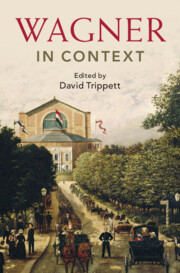Book contents
- Wagner in Context
- Composers in Context
- Wagner in Context
- Copyright page
- Contents
- Illustrations
- Musical Examples
- Contributors
- Acknowledgements
- Abbreviations
- Introduction
- I Place
- II People
- III Politics, Ideas, and Bodies
- IV Life, Language, and the Ancient World
- V Music and Performance
- VI Reception
- Chapter 35 Regietheater in Performance
- Chapter 36 Twentieth-Century Reception and Anti-Semitism
- Chapter 37 Bayreuth as Idea: Chamberlain, Wolzogen, Hitler
- Chapter 38 Performing Wagner in Israel: An Affront or a Tribute?
- Chapter 39 Nineteenth-Century Music Criticism
- Chapter 40 Wotan’s Stormtroopers and the Total Art Machine: Kittler’s Ring of the Nibelung
- Chapter 41 Sound Recording
- Chapter 42 The Wagnerian Erotics of Video Game Music
- Further Reading
- Select Bibliography
- Index
Chapter 42 - The Wagnerian Erotics of Video Game Music
from VI - Reception
Published online by Cambridge University Press: 14 March 2024
- Wagner in Context
- Composers in Context
- Wagner in Context
- Copyright page
- Contents
- Illustrations
- Musical Examples
- Contributors
- Acknowledgements
- Abbreviations
- Introduction
- I Place
- II People
- III Politics, Ideas, and Bodies
- IV Life, Language, and the Ancient World
- V Music and Performance
- VI Reception
- Chapter 35 Regietheater in Performance
- Chapter 36 Twentieth-Century Reception and Anti-Semitism
- Chapter 37 Bayreuth as Idea: Chamberlain, Wolzogen, Hitler
- Chapter 38 Performing Wagner in Israel: An Affront or a Tribute?
- Chapter 39 Nineteenth-Century Music Criticism
- Chapter 40 Wotan’s Stormtroopers and the Total Art Machine: Kittler’s Ring of the Nibelung
- Chapter 41 Sound Recording
- Chapter 42 The Wagnerian Erotics of Video Game Music
- Further Reading
- Select Bibliography
- Index
Summary
This chapter argues that Wagner’s Schopenhauerian understanding of music reveals important aspects of video game music, particularly its erotic dimensions. Armed with, on the one hand, a Wagnerian-Schopenhauerian understanding of music, erotics, and metaphysics, and on the other Kulezic-Wilson’s erotics of cinematic listening, the chapter proposes a Wagnerian erotics of game music on three counts. First, music is an element of the video game medium that dissolves hard boundaries of a single ‘self’ of the player’s identity and takes players ‘out of themselves’. Secondly, games give musical voice to the will, and chart our interaction with it. Finally, games often use musical structures that arrest any broader sense of development, creating a temporal suspension and denial of the will that Wagner sought to reflect in his musical fabric. This chapter concludes with a brief case study that identifies these three elements – identity, the will, and temporality – in The Dig (1995).
Keywords
- Type
- Chapter
- Information
- Wagner in Context , pp. 421 - 431Publisher: Cambridge University PressPrint publication year: 2024

